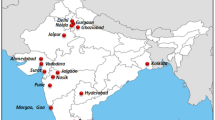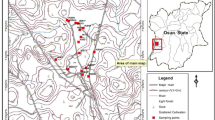Abstract
In urban cities, the environmental services are the responsibility of the public sector, where piped water supply is the norm for urban household. Likewise, in Beirut City (capital of Lebanon) official water authorities are the main supplier of domestic water through a network of piping system that leaks in many areas. Beirut City and its suburbs are overpopulated since it is the residence of 1/3 of the Lebanese citizens. Thus, Beirut suffers deficiency in meeting its water demand. Water rationing, as a remedial action, is firmly established since four decades by the Lebanese Water Authorities. Consumers resorted then to private wells to supplement their domestic water needs. Consequently, household water quality is influenced by external factors relating to well water characteristics and internal factors depending on the types of the pipes of the distribution network and cross connections to sewer pipes. These factors could result in chemical and microbial contamination of drinking water. The objective of this study is to investigate domestic water quality variation in Beirut City emerging form the aforementioned factors. The presented work encircles a typical case study of Beirut City (Ras Beirut). Results showed deterioration pattern in domestic water quality. The predicted metal species and scales within the water pipes of distribution network depended on water pH, hardness, sulfate, chloride, and iron. The corrosion of iron pipes mainly depended on Mg hardness.
Similar content being viewed by others
References
Acra, A., & Ayoub, G. M. (2001). Indicators of coastal groundwater quality changes induced by seawater infiltration. International Journal of Environmental Studies, 58, 761–769.
Acra, A., Raffoul, Z., & Karahogopian, N. (1983). Long-term investigation of sea water infiltration and ground water quality in Greater Beirut. In MESAEP, proceedings: Second international meeting on environmental pollution in the Mediterranean region, Iraklion, Crete, 6–7 September 1983.
APHA – American Public Health Association (1998). Standard methods for the examination of water and wastewater, 20th edn. Washington DC: American Public Health Association.
Brazilay, J. I., Weinberg, W. C., & Eley, J. W. (1999). The water we drink. New Brunswick, NJ: Rutgers University Press.
Drever, J. I. (1997). The Geochemistry of Natural Waters: Surface and Groundwater Environments, 3rd edn. Prentice Hall, New Jersey, USA.
ECODIT (2002) State of environment in Lebanon. Report submitted to the Ministry of Environment, Lebanon.
El-Fadel, M., Maroun, R., Semerjian, S., & Harajli, H. (2003). A health-based socio-economic assessment of drinking water quality: The case of Lebanon. Management of Environmental Quality, 14(3), 353–368.
Faaour, A. (1993). Lebanon atlas (in Arabic). Beirut, Lebanon: Geographical Institution Inc.
Ford, T., & Colwell, R. (1996). A global decline in microbiological safety of water: A call for action. Washington, DC: American Academy of Microbiology.
Jaber, B. (1997). Water in Lebanon: Problems and solutions. Public lecture given in the Department of Hydrology, Purdue University, Lafayette, IN, April 1997.
Jurdi, M., Kambris, M., & Basma, S. (2002). Development of drinking water quality control programs: Challenges for sustainability. Journal of Environmental Practice, 4(2), 72–74.
Kjellen, M. (2000). Complementary water systems in Dar es Salaam, Tanzania: The case of water vending. Water Resource Development, 16, 143–154.
Lababidi, H., Shatela, A., & Acra, F. (1987). The progressive salination of ground water in Beirut, Lebanon. International Journal of Environmental Studies, 30, 203–208.
Lin, J., Ellaway, M., & Adrien, R. (2001). Study of corrosion material accumulated on the inner wall of steel water pipe. Corrosion Science, 43, 2065–2081.
Pathan, M. D. (1977). Pollutional aspects of water resources in Lebanon, volume 1. MS thesis, American University of Beirut, Lebanon.
Peltekian, A. A. (1980). Groundwater quality of Greater Beirut in relation to geologic structure and the extent of seawater intrusion. MS thesis, American University of Beirut, Lebanon.
Saghir, J., Schiffler, M., & Mathewos, W. (2000). Urban water and sanitation in the Middle East and North Africa region: The way forward. Washington, D.C.: World Bank Publication.
Sander, A., Berghult, B., Ahlberg, E., Broo, A. E., Johansson, E. L., & Hedberg, T. (1997). Iron corrosion in drinking water distribution systems-surface complexation aspects. Corrosion Science, 39(1), 77–93.
Sarine, P., Snoeyink, V. L., Bebee, J., Jim, K. K., Beckett, M. A., Kriven, W. M., et al. (2004). Iron release from corroded iron pipes in drinking water distribution systems: Effects of dissolved oxygen. Water Research, 38, 1259–1269.
Sarine, P., Snoeyink, V. L., Bebee, J., Kriven, W. M., & Clement, J. A. (2001). Physio-chemical characteristics of corrosion scales in old iron pipes. Water Research, 35(12), 2961–2969.
Stumm, W., & Morgan, J. J. (1996). Aquatic chemistry, chemical equilibria and rates in natural waters, 3rd edn., Chap. 10., Trace metals: Cycling, regulation, and biological role. New York: Wiley.
Tang, Z., Hong, S., Xiao, W., & Taylor, J. (2006). Characteristics of iron corrosion scales established under blending of ground water surface, and saline waters and their impacts on iron release in the pipe distribution system. Corrosion Science, 48(2), 322–342.
WHO (2004). Guidelines for drinking-water quality. Volume 1. Recommendations, 3rd edn. Geneva, Switzerland.
Author information
Authors and Affiliations
Corresponding author
Rights and permissions
About this article
Cite this article
Korfali, S.I., Jurdi, M. Assessment of domestic water quality: case study, Beirut, Lebanon. Environ Monit Assess 135, 241–251 (2007). https://doi.org/10.1007/s10661-007-9646-x
Received:
Accepted:
Published:
Issue Date:
DOI: https://doi.org/10.1007/s10661-007-9646-x




